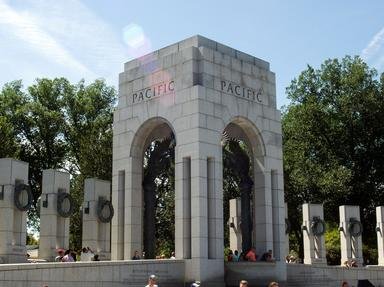Quiz Answer Key and Fun Facts
1. Code breakers determined the next Japanese objective was code named "AF". In order to see if Midway was "AF", a false radio message was sent uncoded from Midway. What issue did this bogus message say Midway was having trouble with?
2. One aircraft carrier from task force 17 was badly damaged at the Battle of the Coral Sea. Which survivor of the Coral Sea battle was repaired enough at Pearl Harbor in 72 hours to participate at Midway?
3. An atoll named French Frigate Shoals was to be the location for an important Japanese mission. What was to take place there?
4. Why was a picket line of Japanese submarines unable to detect US forces approaching Midway?
5. Admiral Nagumo launches a strike with over 100 aircraft against Midway. At the same time, search planes are launched from escort vessels, to look for US warships. Search plane #4 from the cruiser IJN Tone spots US ships, but its report is delayed about 30 minutes. What caused this?
6. The Japanese Naval airstrike against Midway was not as effective as hoped. The strike commander advised another strike was needed. This was no great concern, since a second strike force was standing by for just this purpose.
7. Scout #4 from the cruiser Tone reported sighting US surface ships. Eventually a follow up report included sighting an aircraft carrier among this force. The Midway strike force was returning and needed to land. Admiral Nagumo now had to decide how to react. What action did he order?
8. US Navy Catalina floatplanes locate the Japanese carriers. Unfortunately, US task forces 16 and 17 failed to coordinate their attacks not only with each other, but even among each carriers own air group. As a result, the first attackers were the old, slow TBD Devastator torpedo bombers. USS Hornet's torpedo 8 squadron consisted of 15 planes with a flight crew of two each. How many of the 30 men survived torpedo 8's first combat mission?
9. Enterprise had 30 Dauntless dive bombers looking for the exact location of the Japanese carriers. Just before aborting their strike, how did these fliers locate the enemy carriers?
10. Enterprise's 30 Dauntless dive bombers, along with 17 from the Yorktown, arrive above the Japanese carrier task forces. Normally a combat air patrol (CAP) of fighter aircraft would have intercepted and engaged the bombers. Why did this not occur?
11. The 30 bombers from Enterprise were supposed split into their sub-units, bombing 6 and scouting 6, 15 planes each. Each 15 plane unit was then to attack a different flattop. This plan failed as all 30 dive bombers converged on the largest carrier, the Kaga. Three planes broke away and attacked Nagumo's flagship, the carrier Akagi. Each plane carried one 500 pound bomb. How many hits were scored on Akagi?
12. On the Hiryu, Admiral Yamaguchi was the senior officer left unaffected by the attacks on the carrier strike force. He quickly ordered a strike composed of every plane he could muster on short notice. 18 Vals with only 6 Zeros for escort follow US planes returning to their carriers after the fateful strike. They attack which US vessel?
13. Yamaguchi launches a second attack against US carriers. Of the 10 Kates involved in the attack, half are shot down. But two torpedo hits are scored against what must be a healthy carrier. Why were the Japanese wrong with this assessment?
14. After Hiryu's second attack against Yorktown occurred, Hiryu was hit and mortally wounded by which American force?
15. Overall command of task forces 16 and 17 was given to Admiral Spruance after Admiral Fletcher had to transfer his flag from the badly damaged Yorktown. As darkness fell and aircraft were recovered from the Hiryu strike, what orders did Spruance give to preserve his ability to fight again?
Source: Author
pointluck
This quiz was reviewed by FunTrivia editor
bloomsby before going online.
Any errors found in FunTrivia content are routinely corrected through our feedback system.

